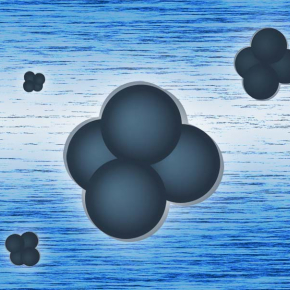One more step towards the observation of the tetraneutron

A resonance structure compatible with a quasi-bound tetraneutron has been observed by scientists of the SAMURAI collaboration in RIKEN, Japan, in which a team from LPC Caen is involved. This observation confirms the first clues obtained 20 years earlier at GANIL and will force to reconsider the simulation models of the cohesion of nucleons in the atomic nucleus.
The free neutron has a lifetime of 15 minutes. On the other hand, it is stable when bound in nuclei or in neutron stars, compact and dense objects composed mainly of neutrons and which can exist only thanks to gravitation. On a completely different scale from neutron stars, an exciting quest has been pursued for several decades, looking for very light systems composed of only a few neutrons.
In the early 2000s, measurements were carried out at GANIL and the first indications were published on the existence of a small aggregate composed of 4 neutrons: the “tetraneutron”. It was obtained by breaking the 14Be nucleus into 10Be and a system of 4 neutrons. Does such a neutral system exist? If so, is it bound, even weakly, or is it a resonance? How, if it is the case, does the nuclear interaction allow to bind this system where protons are absent? Indications of the existence of the tetraneutron, in a bound state or in a quasi-bound resonance form, have been obtained during the following years, but no certainty has been established.
A breakup reaction makes the tetraneutron appear
The same team of the Laboratoire de Physique Corpusculaire in Caen (LPC Caen) responsible for the measurements made at GANIL some twenty years ago, has just participated, within the SAMURAI collaboration, in the publication in the journal NATURE of the measurements carried out at the ‘Radioactive Ion Beam Factory’ at RIKEN in Japan. It consists of a breakup reaction, 8He(p,p4He)4n, illustrated schematically in the figure below.

The target proton ejects an alpha particle (4He) from the 8He projectile nucleus, leaving the remaining 4 neutrons unperturbed in a highly correlated resonant state. A resonance structure compatible with a quasi-bound tetraneutron has indeed been observed in a very clear way, after decades of experimental quest. The energy of the tetraneutron has been reconstructed by an energy balance of the reaction, with the so-called missing mass method, by measuring the energy of the proton and of the alpha particle.
Improving the modeling of nuclear systems
Some theoretical studies where the nuclear interaction is treated in a more or less phenomenological way have shown that a resonant tetraneutron could exist, with a very short lifetime. However, other more microscopic approaches called ab-initio, i.e. formalized from the elementary interaction between neutrons, do not predict such a resonance. This experimental result represents an important challenge: if it turns out that it is not possible to explain otherwise (than by the existence of a resonant tetraneutron) the strong correlation observed recently, the way of constructing the nuclear interaction in ab-initio approaches should probably be revisited and formalized in a slightly different framework.
This result represents an important step that will allow, among other things, to test the way nuclear physicists describe the interaction between nucleons and consequently to improve the modeling of nuclear systems, not only nuclei, but also infinite nuclear matter, an infinite ideal system composed of nucleons whose study helps to understand the properties of nuclei and neutron stars.
Read more
-
Observation of a correlated free four-neutron system / Nature : 606, p.678–682 (2022) , M. Duer, T. Aumann, M. V. Zhukov, et al.Observation of a correlated free four-neutron system / Nature : 606, p.678–682 (2022) , M. Duer, T. Aumann, M. V. Zhukov, et al.
-
The quest for light multineutron systems / European Physical Journal A, EDP Sciences, 2021, 57 (3), pp.105, F. Miguel Marques, Jaume CarbonellThe quest for light multineutron systems / European Physical Journal A, EDP Sciences, 2021, 57 (3), pp.105, F. Miguel Marques, Jaume Carbonell
-
IN2P3 newsIN2P3 news